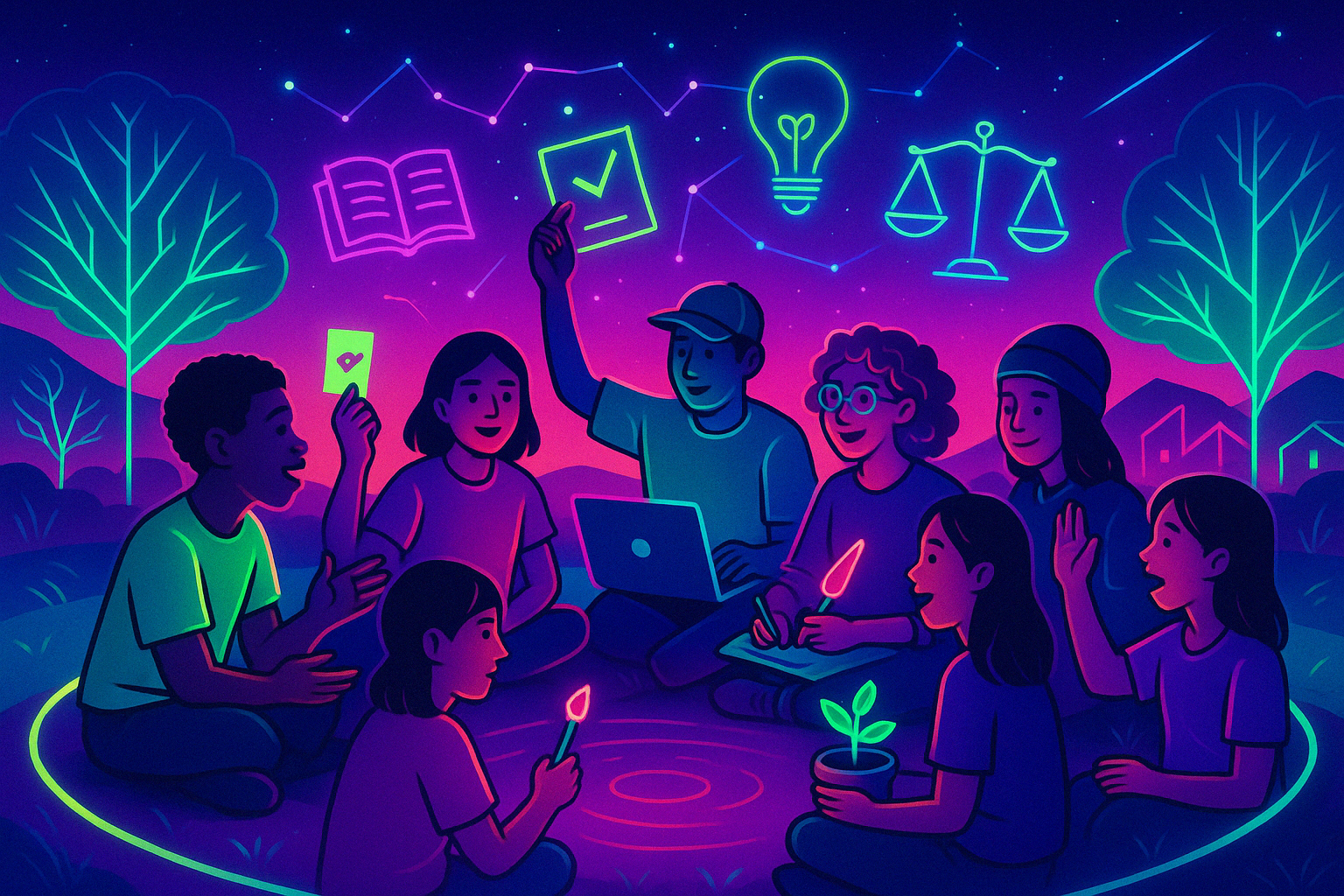
 John Moravec
John MoravecKids are people, too
Most schools are built on control. Students are told when to sit, when to speak, what to study, and how to behave. They are ranked, sorted, and measured, usually without ever being asked what they think. Decisions about what counts as learning, and how it happens, are made for them, not with them.
That’s a problem.
Young people are citizens from birth, not apprentices to adulthood. They are the ones most affected by education policies, curriculum decisions, and school rules. Yet, they most often have the least power to shape them. As stakeholders in both school and society, they deserve a meaningful role in shaping their learning and their futures. The challenges they will face (e.g., ecological collapse, social fragmentation, rapid technological change) demand agency, rooted in respect and trust.
Many of the barriers to student agency are baked into the structure of schooling itself. Standardized testing regimes narrow the curriculum and constrain both teacher and student choice, sending a clear message: what counts is what’s measurable. In many countries, legal frameworks treat students as passive recipients of instruction rather than as rights-bearing individuals with a say in their education. Even where participation is encouraged, cultural assumptions about childhood (particularly the idea that young people lack the maturity or judgment to meaningfully contribute) undermine efforts to include them in decision-making. These structural obstacles reflect deeper values about power, control, and whose voice matters. Until these constraints are addressed, efforts at inclusion will remain limited to surface-level reforms. Authentic change demands dismantling the systems that deny students the ability to shape their own learning.
From Manifesto 25:
Kids are people, too. All students must be treated and respected as human beings with recognized, universal human rights and responsibilities. This means students must have an active say in the choices regarding their learning, including how their schools are run, how and when they learn, and all other areas of everyday life. This is inclusion in a real sense. Students of all ages must be afforded liberties to pursue educational opportunities and approaches for learning that are appropriate for them, as long as their decisions do not infringe on the liberties of others to do the same (adapted from EUDEC, 2023).
Inclusion as shared power and responsibility
Inclusion about participation, not presence. Typically, “student voice” is reduced to token surveys, scripted forums, or assignments where the format is open but the outcome is predetermined. These token gestures mask the top-down nature of school decision-making and give the illusion of inclusion without shifting any real power.
Students should have a hand in shaping curriculum, timetables, discipline policies, and all facets of school governance. This is already in practice around the world:
- In Finland, many schools practice student democracy through structured class meetings, student-led initiatives, and integration of student councils into school governance. Participation is built into the culture, not bolted on as an afterthought.
- In India, organizations such as Shikshantar have supported unschooling and learner-directed models that respect children as capable decision-makers. Learners co-design their days, pursue community-based projects, and document their learning journeys without grades or rigid timetables.
- Throughout Europe, democratic schools within the European Democratic Education Community operate on principles where students and staff share equal voting rights on all matters, from budgeting to curriculum to staffing.
- In South Africa, the Equal Education movement mobilized students to speak up about school conditions, infrastructure, and inequality, effectively pushing for policy change by elevating youth voices in national education debates.
What happens when we place more trust in kids? They turn out just fine. When students are trusted to co-create the structures and rhythms of school life, the outcomes are measurable and lasting. A 2024 study of Sudbury-type schools (Hartkamp-Bakker & Martens, 2024) found that students who exercised real choice in their education developed stronger self-determination, motivation, and a sense of ownership over their lives. These students reported deeper confidence in their abilities and a clearer sense of personal responsibility. More broadly, research from democratic and learner-directed schools confirms that when students help shape their learning environments, they engage more fully, take greater initiative, and develop skills like negotiation, collaboration, and accountability through lived experience. Being heard and holding real responsibility teaches young people what it means to belong, and it prepares them to contribute meaningfully to their communities.
Responsibility as lived learning experiences
A rights-based approach to education is accompanied by responsibilities. But responsibility is something that must be co-developed and agreed to by all parties. That is, it’s not imposed, it’s practiced. This happens through resolving conflicts, setting shared norms, managing group projects, co-creating school priorities, caring for the state of their learning environments, and even through free play (Gray, 2023). When students are partners rather than subjects in the education process, accountability becomes mutual. Schools become less about control and more about contribution, less about managing behavior and more about nurturing belonging.
The Sudbury Valley School in Massachusetts, USA serves as an example of what real inclusion through shared power and responsibility can look like in practice. At Sudbury, students of all ages have equal voting rights with staff on all matters, from school rules to hiring decisions. There is no imposed curriculum, no grading system, and no compulsory classes. Instead, students are trusted to direct their own learning, whether that means diving into music composition, programming, painting, or simply talking with peers. Governance happens through democratic assemblies and student-run judicial committees, where even a six-year-old can hold a fifteen-year-old accountable and vice versa. In this model, shared power and responsibility is practiced daily.
In Peru, the Escuela Democrática de Huamachuco (formed in partnership with the Kapriole school of Freiburg, Germany) was inspired by the principles of democratic education, environmental awareness, human rights, and adapted to local Andean traditions. This rural school operates with the belief that children are full citizens of the school community. Students participate in weekly assemblies where they propose and vote on school matters, ranging from schedules and curriculum themes to conflict resolution processes. There are no formal grades. Instead, learning is guided by student interests, community needs, and collective agreements. Responsibility is a lived experience in the school: students organize clean-up rotations, co-facilitate workshops, and help manage school resources. The experience fosters autonomy, mutual respect, and a deep sense of civic responsibility grounded in local cultural values.
These outcomes happen when students are treated as people whose voices shape their educational lives, not as subjects to be managed. When schools operate on the premise that young people deserve agency, respect, and participation, they cultivate more democratic cultures. Still, realizing these rights is not simply a matter of changing attitudes. This includes questioning long-standing school policies, schedules, grading systems, and the very assumption that adults always know best. It requires dismantling structural barriers that limit student agency and codify compliance as the norm.
In many education systems, student rights are constrained by policies and norms that prioritize standardization and control. High-stakes testing regimes narrow the curriculum and reduce students’ roles to passive test-takers. Legal frameworks often deny students basic decision-making power, from governance to discipline. Cultural assumptions about childhood further compound the problem, framing young people as too naïve or immature to participate meaningfully in decisions that affect them. We need a fundamental redesign of how we approach school to break these barriers, and they should start with two simple principles: respect and trust.
Starting with respect and trust
All people are entitled to basic human rights, especially young people. Children and youth are protected under the UN Convention on the Rights of the Child. That includes the right to be heard in decisions affecting them, the right to education that supports their development and well-being, and the right to freedom of thought and expression.
Yet these rights are often ignored in schools designed around control. Respect should not depend on age or obedience. It should be the starting point. Students deserve systems that presume capability, support agency, and invite participation.
Fostering student agency enables purpose. It requires designing systems where responsibility is shared, curiosity is nurtured, and participation is taken seriously. Trusting students means involving them in shaping the future at every stage of their learning, not waiting until they’re older or deemed “ready.”
Toward learner-led futures
If we want democratic societies, we need democratic schools. If we want creative thinkers, we need to stop punishing curiosity. And if we want inclusive systems, we need to include students in how those systems are run. They must be afforded agency, together with associated rights and responsibilities.
This requires a redesign on how we approach mainstream education, centered on giving up control that was never fairly held, and refocusing on respect and trust. Students are people, already thinking, choosing, becoming. Whether or not we recognize kids as people, too, will determine whether education becomes a site of liberation or continued control.
Read and sign Manifesto 25 at https://manifesto25.org
References and recommended readings
EUDEC. (2023). EUDEC guidance document. European Democratic Education Community. https://eudec.org/about-us/guidance-document/
Gray, P. (2023). Self-directed education: Unschooling and democratic schooling. Oxford University Press. https://doi.org/10.1093/acrefore/9780190264093.013.80
Hartkamp-Bakker, C. and Martens, R. (2024), “True choice and taking ownership of life: a qualitative study into self-determination in Sudbury model schools”, On the Horizon, 32(2/3), pp. 130-144. https://doi.org/10.1108/OTH-03-2024-0008

